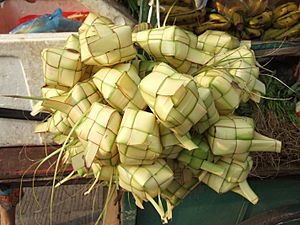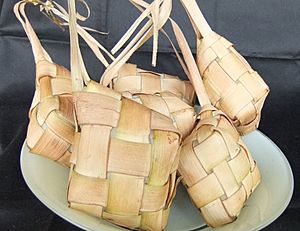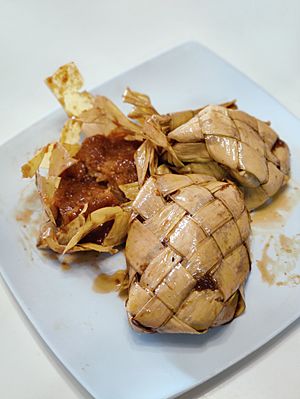Ketupat facts for kids
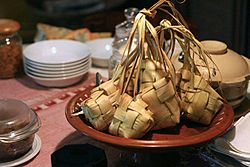
Unopened bunch of cooked ketupat on a plate.
|
|
| Alternative names | Kupat, tupat, topat, tipat |
|---|---|
| Course | Main course |
| Place of origin | Indonesia |
| Region or state | East and Central Java |
| Serving temperature | Hot or room temperature |
| Main ingredients | Rice cooked inside of a pouch made from woven young palm leaves |
| Variations | Ketupat pulut, ketupat daun palas (Malay), lepet |
| 1 bowl of ketupat sayur has approximately 93 kcal | |
Ketupat (also called Kupat in Javanese and Sundanese, or Tipat in Balinese) is a special rice cake. It's cooked inside a diamond-shaped pouch made from woven young palm leaves. This tasty dish started in Indonesia. You can also find it in Brunei, Malaysia, Singapore, and southern Thailand. People often call it "packed rice." Other similar packed rice dishes include lontong and bakchang.
To eat ketupat, you cut open the woven palm leaf skin and remove it. The rice cake inside is then cut into smaller pieces. It's often served as a main food instead of plain steamed rice. People usually enjoy it with dishes like rendang (a rich meat stew), opor ayam (chicken in coconut milk), sayur labu (chayote soup), or sambal goreng hati (spicy liver). It also goes well with satay (meat skewers) or gado-gado (mixed vegetables with peanut sauce). Ketupat is also the main part of dishes like ketupat sayur (ketupat in chayote soup) and kupat tahu (ketupat and tofu in peanut sauce).
Ketupat is similar to dishes found in other Austronesian cultures that grow rice. For example, the Filipino puso or Patupat is a similar dish. However, puso can come in many different woven shapes, not just diamonds. Long ago, a version called katupat was also found in Guam and the Mariana Islands.
Contents
The Story of Ketupat
Using woven young palm leaves (called janur) to cook food is common in Maritime Southeast Asia. This includes places like Java, Indonesia, Malaysia, Singapore, and the Philippines. Ketupat is made by wrapping rice in these woven palm leaf pouches and then boiling them. As the rice cooks, it expands and fills the pouch, becoming a firm rice cake. This cooking method gives ketupat its special shape and texture.
An Indonesian religious leader named Sunan Kalijaga is believed to have first introduced ketupat. He was a very important person for Muslims in Java. In Java and most of Indonesia, ketupat is closely linked to the Islamic festival of lebaran (Eid ul-Fitr). The idea of connecting ketupat with lebaran likely started in the 15th-century Demak Sultanate.
According to Javanese stories, the Indonesian lebaran tradition began when Sunan Bonang, another Muslim saint from Tuban in 15th-century Java, asked Muslims to seek forgiveness after their Ramadhan fast. Raden Mas Sahid, also known as Sunan Kalijaga, introduced the tradition of making and eating ketupat (or kupat) during lebaran. Sunan Kalijaga started the lebaran ketupat ritual on the 8th day of Shawwal. This is a week after Eid ul-Fitr and a day after a six-day Shawwal fast.
It's believed that ketupat has a special meaning. The word kupat in Javanese language sounds like ngaku lepat, which means "admitting one's mistakes." This fits with the tradition of asking for forgiveness during lebaran. The crossed weaving of the palm leaves stands for the mistakes and sins people make. The white rice cake inside represents purity and being free from sins after observing the Ramadhan fast, prayers, and rituals.
Besides Java, the tradition of eating ketupat during Eid ul-Fitr is found all over Indonesia. It's also popular in neighboring countries like Malaysia, Singapore, and Brunei. For centuries, ketupat has also been used as "sajen" (an offering for ancestors). People would hang bunches of ketupat at their doors to welcome the spirits of ancestors they believed would visit.
Some old stories say that sailors created this way of cooking rice. They needed a way to keep cooked rice from spoiling during long sea trips. The coco leaves used to wrap the rice are always shaped like a triangle or diamond. They are hung in bunches in the open air. This shape helps moisture drip away from the cooked rice. The leaves also let air get to the rice, which keeps it fresh. At the same time, they protect the rice from flies and insects.
Even though ketupat is now strongly linked to the Muslim festival of lebaran, it's also known in non-Muslim communities. For example, Hindu Balinese people and people in the Philippines know about it. This suggests that weaving coconut fronds for food might have started before Islam arrived. It was connected to a local Hindu ritual honoring Dewi Sri, the Javanese goddess of rice. Balinese Hindus still weave Cili fronds (an image of Dewi Sri) as an offering. They also weave tipat fronds during the Kuningan Balinese Hindu holy day.
Special Celebrations
In many parts of Indonesia, there is a special event called Lebaran Ketupat. This happens after six extra days of fasting following Idul Fitri. In Lombok, West Nusa Tenggara, thousands of Muslims celebrate Lebaran Ketupat (or Lebaran Topat). They visit the graves of Muslim scholars. Then, they join in community activities. These include music, ketupat cooking contests, and shared meals where ketupat is the main dish. Side dishes might be plecing kangkung (stir-fried water spinach) or Ayam Taliwang (a local chicken dish).
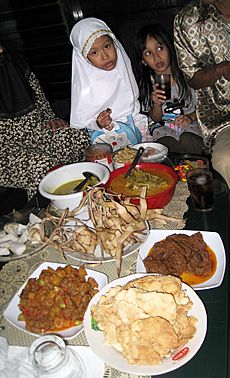
In Central Java, Lebaran Ketupat is called Bada Kupat. People celebrate by cooking and serving ketupat and lepet (steamed sticky rice in palm leaves) in Semarang. In Colo, Kudus Regency, there's a parade of gunungan (cone-shaped offerings) made of ketupat, lepet, and other foods. This parade happens on the slope of Mount Muria near the grave of a famous Muslim preacher, Sunan Muria. On the slope of Mount Merapi in Boyolali Regency, the celebration includes a parade of farm animals decorated with ketupat.
Among Hindu communities in Bali and Banyuwangi in East Java, ketupat is part of the offerings and rituals for the Kuningan festival. This festival concludes the Galungan holy days. During Galungan, Hindu families make and put up a penjor pole made of janur (young palm leaves). They then make offerings at the Pura. Ten days after Galungan, the Kuningan ceremony takes place. To celebrate Kuningan, Balinese Hindu families first make tipat or ketupat as an offering. After that, they eat some ketupat.
There are some interesting similarities between the Javanese Muslim Lebaran and Balinese Hindu Galungan-Kuningan holy days. Ketupat is one of these similarities. For example, families visit the graves of their family or ancestors before the holy day. They also eat ketupat to end the religious festival. Today, ketupat is strongly linked to the Muslim celebration of Idul Fitri in Indonesia. However, these similarities suggest that ketupat might have started in Indonesia before Islam. It was a way for native Indonesians to show thanks and celebrate by making and eating certain foods.
Types of Ketupat
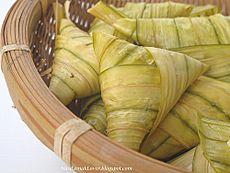
There are many kinds of ketupat. Two common ones are ketupat nasi and ketupat pulut. Ketupat nasi is made from regular white rice. It's wrapped in a square shape using coconut palm leaves. Ketupat pulut is made from glutinous rice (sticky rice). It's usually wrapped in a triangle shape using leaves from the fan palm (Licuala). In Malaysia, ketupat pulut is also called ketupat daun palas. You'll find it mostly in the northern Malay Peninsula and among the Malay community in southern Thailand. Most ketupat pouches are made from janur (young palm leaves). But in Kalimantan, nipah leaves can also be used to weave ketupat.
Ketupat is also a traditional dish served by Indonesians and Malays during open houses for festivals. These include lebaran or Idul Fitri (Hari Raya Aidilfitri). During Idul Fitri in Indonesia, ketupat is often served with opor ayam (chicken in coconut milk), chicken or beef curry, rendang, sambal goreng ati (spicy beef liver), krechek (buffalo or beef skin dish), or sayur labu Siam (chayote soup). Ketupat or lontong can also replace plain steamed rice in dishes like gado-gado, karedok, or pecel.
Dishes Made with Ketupat
Besides being a substitute for steamed rice or lontong in dishes like satay, gado-gado, and ketoprak, ketupat is also a key part of other special dishes.
Ketupat Sayur
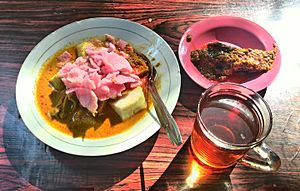
One popular street food in Indonesian cities is Ketupat sayur. This means "ketupat in vegetable soup." There are two well-known versions: the Betawi version from Jakarta and the katupek sayua version from Padang, West Sumatra. Ketupat sayur is a popular breakfast in Jakarta and Padang. It includes ketupat served with sliced labu siam (chayote) and unripe jackfruit gulai. This is in a thin, spicy coconut milk soup. It's topped with cooked tofu, telur pindang (spiced boiled egg), and krupuk crackers. The Padang or Minangkabau version might have extra dishes like egg balado, rendang, and different gulai. If lontong is used instead of ketupat, it's called lontong sayur.
Kupat Tahu

Ketupat is also a main ingredient in the Sundanese and Javanese dish kupat tahu. This dish has ketupat, tahu goreng (fried tofu), and bean sprouts. They are served in a peanut sauce and topped with crispy krupuk crackers. Popular types of kupat tahu include Kupat tahu Kuningan from Kuningan Regency in West Java, Kupat Tahu Padalarang from Padalarang, West Bandung, Kupat Tahu Magelang from Magelang Regency, Central Java, and Kupat tahu Gempol from Surabaya, East Java.
Tipat Cantok
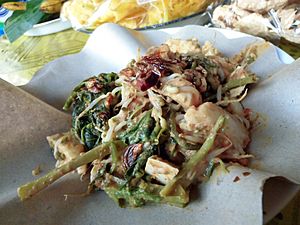
The Balinese version is called tipat cantok. This dish has sliced ketupat with boiled or blanched vegetables. These vegetables include asparagus bean, water spinach, bean sprout, cucumber, and fried tofu. Everything is mixed in a peanut sauce. This sauce is made from ground fried peanuts, garlic, chili pepper, salt, and tauco (fermented soy paste). The peanut sauce can be mild or hot and spicy, depending on how much chili pepper is added. It is one of the few Balinese vegetarian dishes. Tipat cantok is similar to Javanese pecel and Jakartan gado-gado.
Other Uses

In Hindu-majority Bali, ketupat is used as an offering in temples. In Java, among traditional Muslim communities, the empty or uncooked ketupat skin is often hung as an amulet. It is believed to bring wealth and good fortune.
Because ketupat is strongly linked to the Islamic Eid ul-Fitr in Indonesia, Malaysia, southern Thailand, Singapore, and Brunei, it is also used as a decoration. Empty ketupat skins woven from colorful ribbons are used to decorate places for these festive occasions. They are used in the same way that bells are used to celebrate Christmas. Colorful ribbon ketupat are often used to decorate shopping malls, offices, or as decorations for gift packages.
Similar Dishes Around the World
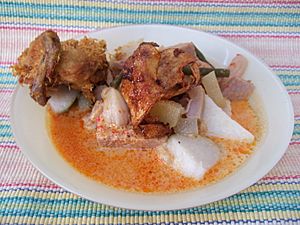
In the Philippines, similar rice pouches are known as puso (meaning "heart"). These dishes came from ancient ritual offerings before colonial times. Unlike ketupat, puso are not limited to diamond shapes. They come in many different weaving styles that are still used by various ethnic groups in the Philippines today. Ketupat are also woven differently. The leaf base and loose leaf strands do not come out at the same point, which is common in most Filipino puso. Ketupat looks most like the tamu pinad version among Muslim Filipinos, which are shaped like a flattened diamond. However, they are also woven differently. Patupat, a sweet treat common in the northern provinces of the Philippines, has the same shape but is cooked differently. Patupat is cooked in sugarcane juice.
In Cambodia, a similar dish is called katom (កាតំ) in Khmer. It's made of pounded sticky rice wrapped in pentagonal woven palm leaves. It's a different version of num kom, which uses banana leaves instead of palm. In Indonesia, other similar dishes of compressed rice in leaf containers include lepet, lontong, lemper, arem-arem, and bacang.
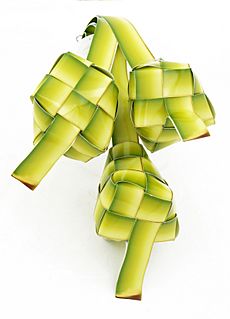
In China, there is a similar dish called lap (苙). It's a local specialty from the island of Hainan. Hainanese lap is usually bigger than Indonesia's ketupat. The lap skin can be woven into a pillow shape or a triangle. The sticky rice inside is filled with pork belly. Outside China, you can also find lap in Port Dickson in Malaysia and Singapore.
See also
 In Spanish: Ketupat para niños
In Spanish: Ketupat para niños



